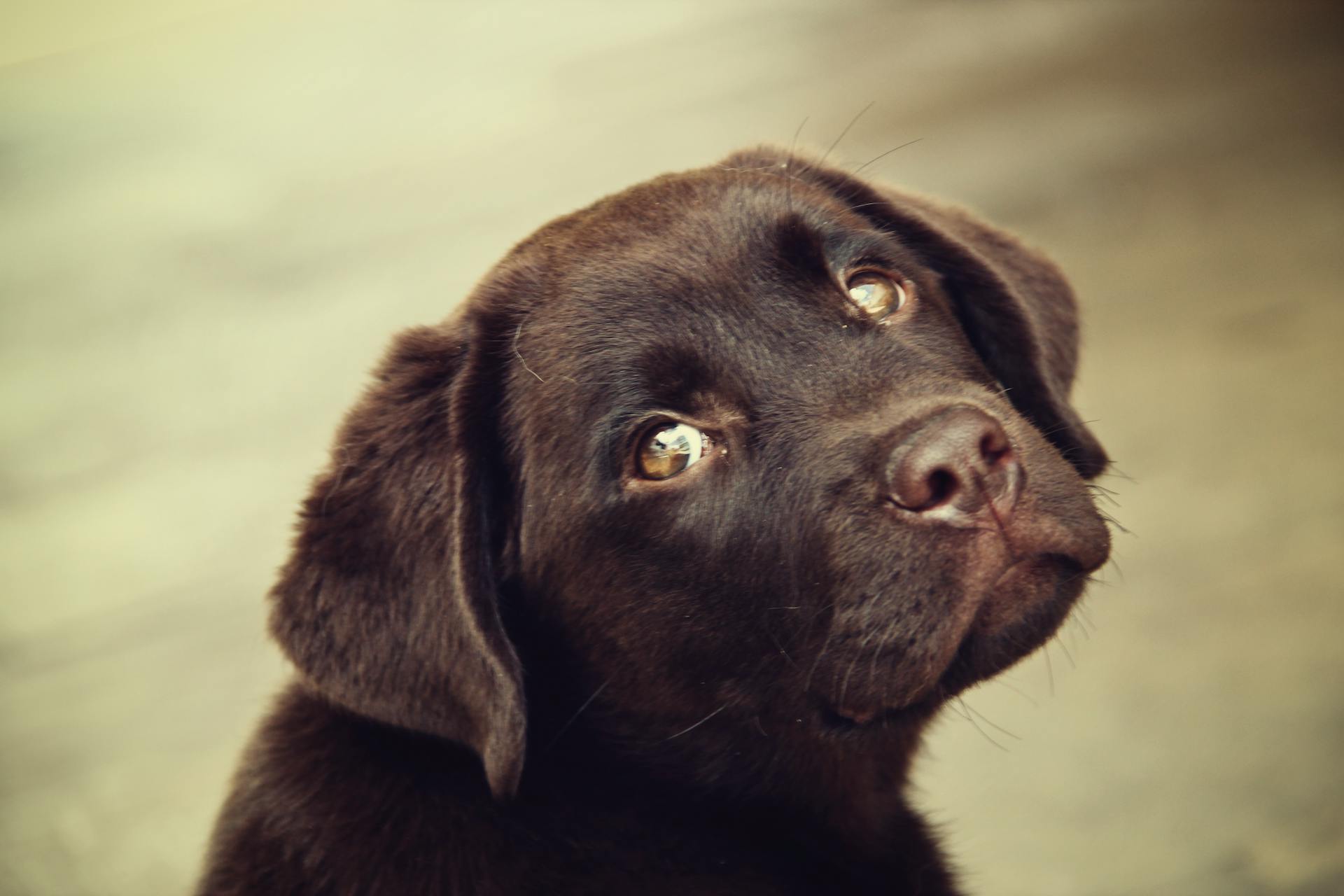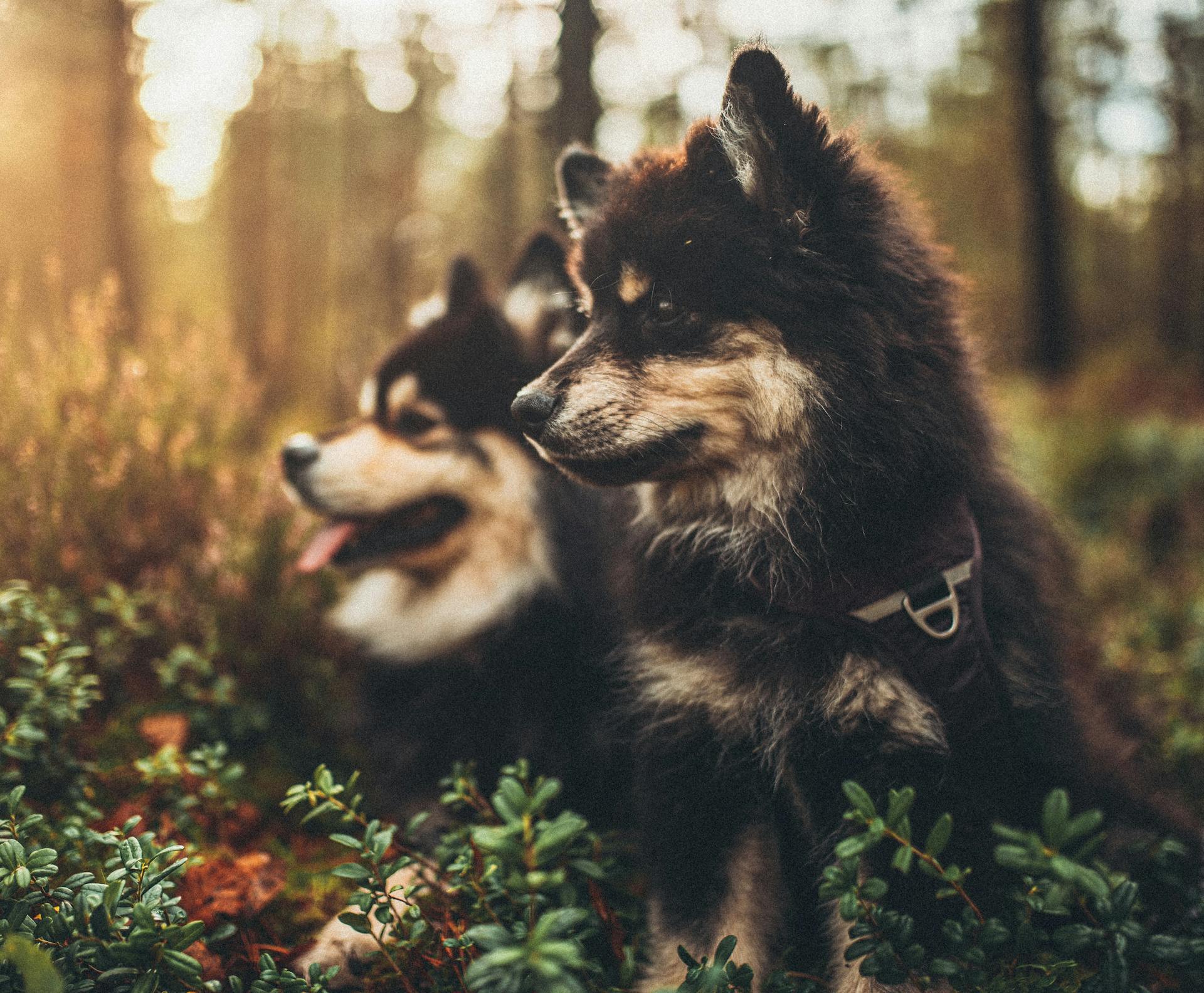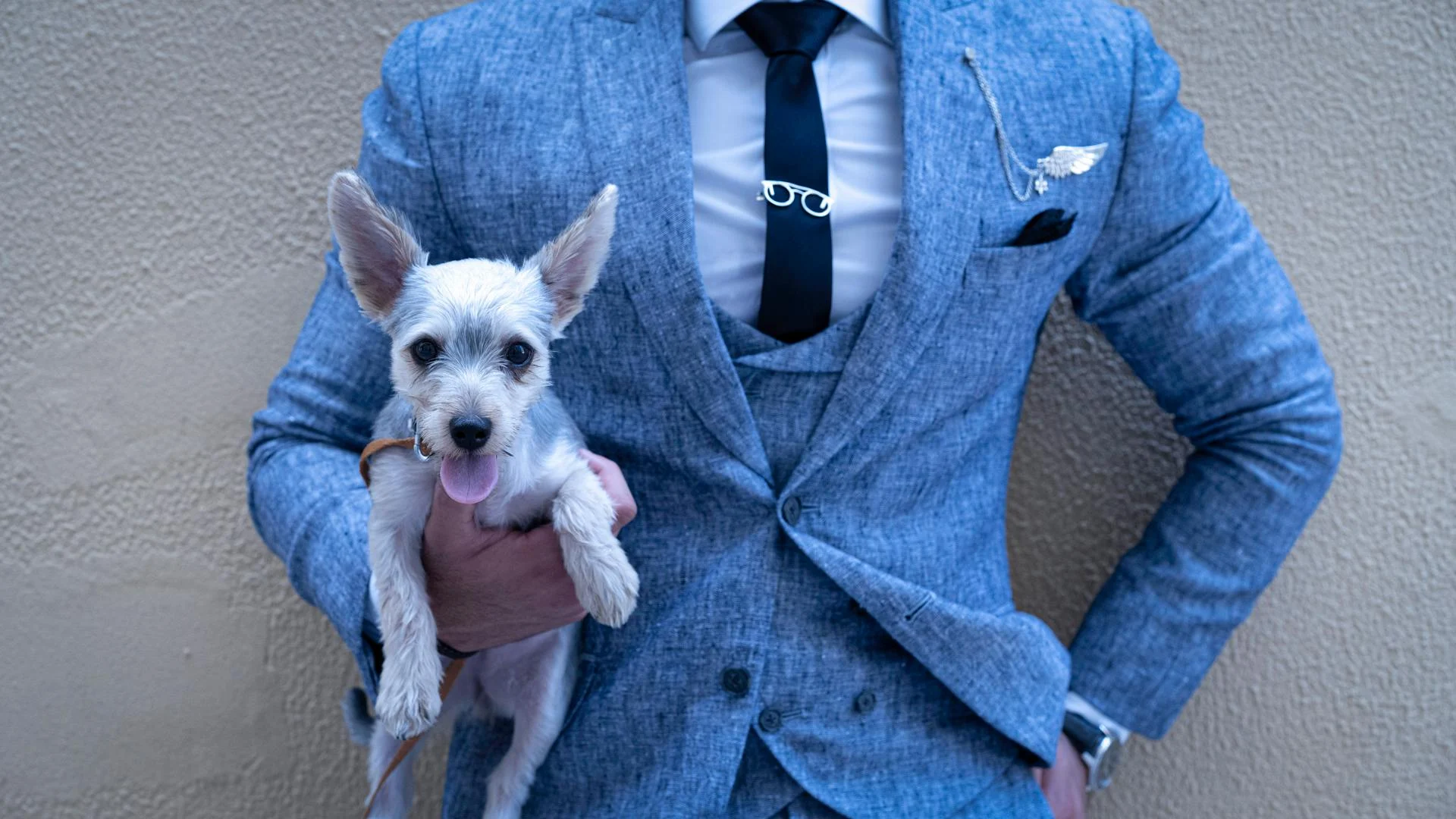
Housetraining your dog requires preparation and patience.
Before bringing your dog home, it's essential to puppy-proof your home by removing any hazardous items or securing toxic substances.
Dogs have a short attention span, so training sessions should be short and frequent.
Consistency is key when housetraining your dog, so establish a routine and stick to it.
Accidents will happen, but it's crucial to clean up after your dog thoroughly with a pet-safe cleaner to remove any lingering scents that might attract them to the same spot again.
For your interest: Home Euthanasia Service for Dogs
Preparation
Preparation is key to successful housetraining. To start, make sure you have a designated potty area outside, such as a grassy spot or a puppy pad.
You'll also want to have a cleaning kit on hand to quickly clean up any accidents that may happen. Use a cleaner that eliminates odors to remove the scent, so your puppy won't use it in the future.
Before bringing your puppy home, prepare a safe and comfortable space for them to sleep and relax. This will help them feel secure and reduce the likelihood of accidents.
Make sure to have a supply of treats on hand to reward your puppy for good behavior. Choose small, easy-to-digest treats that your puppy will love.
A unique perspective: Peanut Butter Dog Training Treats
Training Methods
Consistency is key when it comes to housetraining a puppy. You should establish a regular schedule for feeding, playtime, and potty breaks to help your puppy learn when it's time to go.
A common mistake is allowing your puppy to roam freely in the house without supervision. This can lead to accidents and make housetraining more challenging.
Praise and reward your puppy for eliminating outside, as this positive reinforcement will help them associate going potty outside with good behavior.
A unique perspective: Bell for Dog Potty Training
Accidents and Setbacks
Accidents are a normal part of the house training process, especially with puppies under a year old. They can happen due to incomplete training, changes in environment, or physical problems.
If your puppy has an accident, don't scold them, just clean up the mess and move on. However, if you catch them in the act, make a noise like "AAACCKKK" and quickly take them outside. When they potty outside, praise them and give a treat to reinforce the desired behavior.
Accidents can also be a sign that your puppy needs more frequent potty breaks or a change in their diet and schedule. Keep an eye on your puppy's signs that they need to go, such as sniffing or circling, and take them outside immediately.
Related reading: Potty Training in Apartments for Puppies
Setbacks
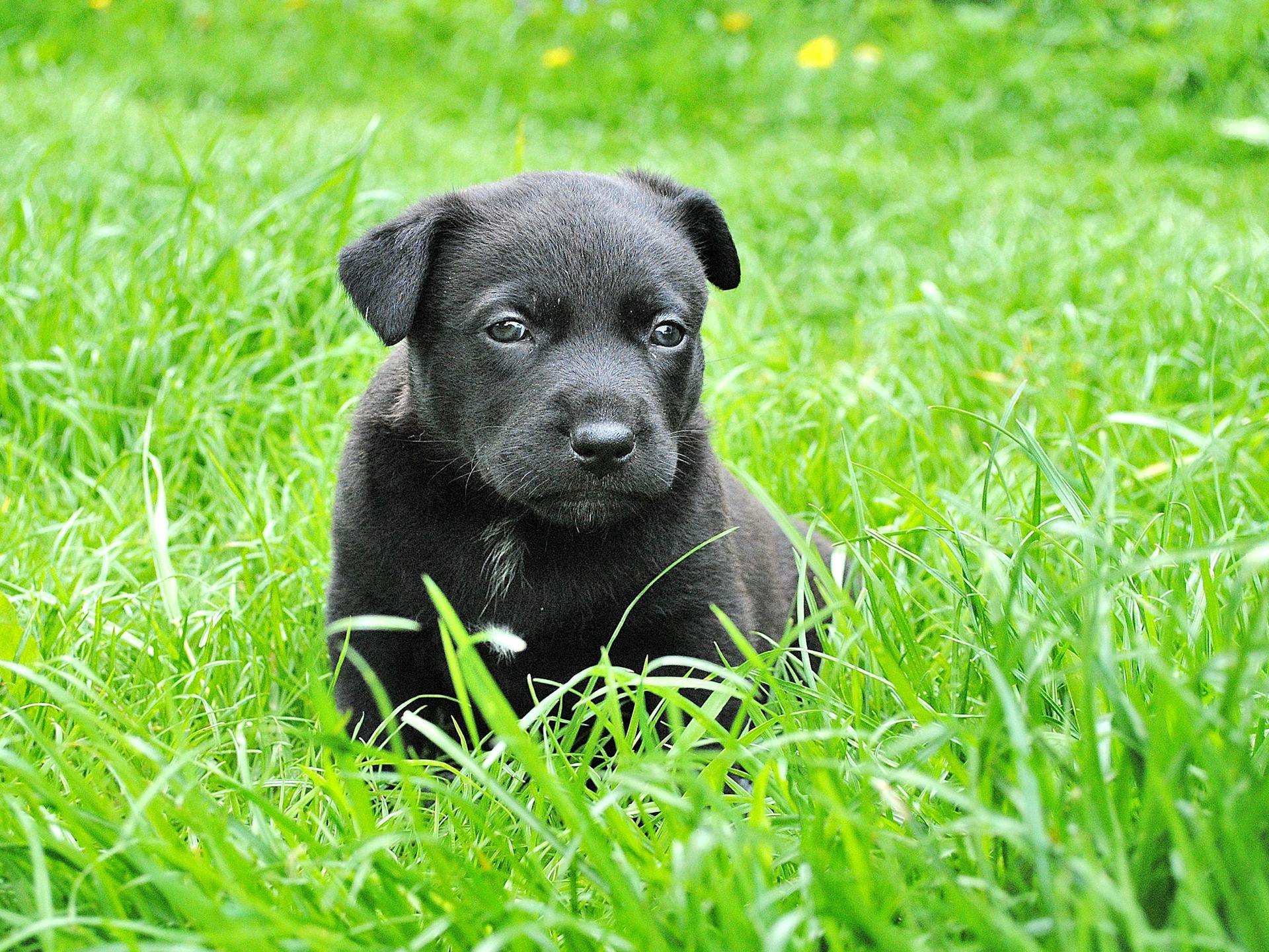
Accidents and setbacks are a normal part of the house training process. Setbacks are common when house training, but as long as you keep taking your puppy out at the first sign they need to go and offering them rewards, they'll learn.
Accidents are common with puppies up to a year old. The reasons for accidents range from incomplete house training to a change in the puppy's environment. If your puppy does have an accident, keep on training. Don't punish your puppy for having an accident.
If you have been house training consistently for a couple of months and your dog is still having trouble, they may have a physical problem that needs to be looked at. Take them in for a full veterinary workup. If the vet says your dog is healthy, your next step may be to see a trainer or dog behaviorist who has experience with house training.
Recommended read: How Do You Keep Dogs Water from Freezing
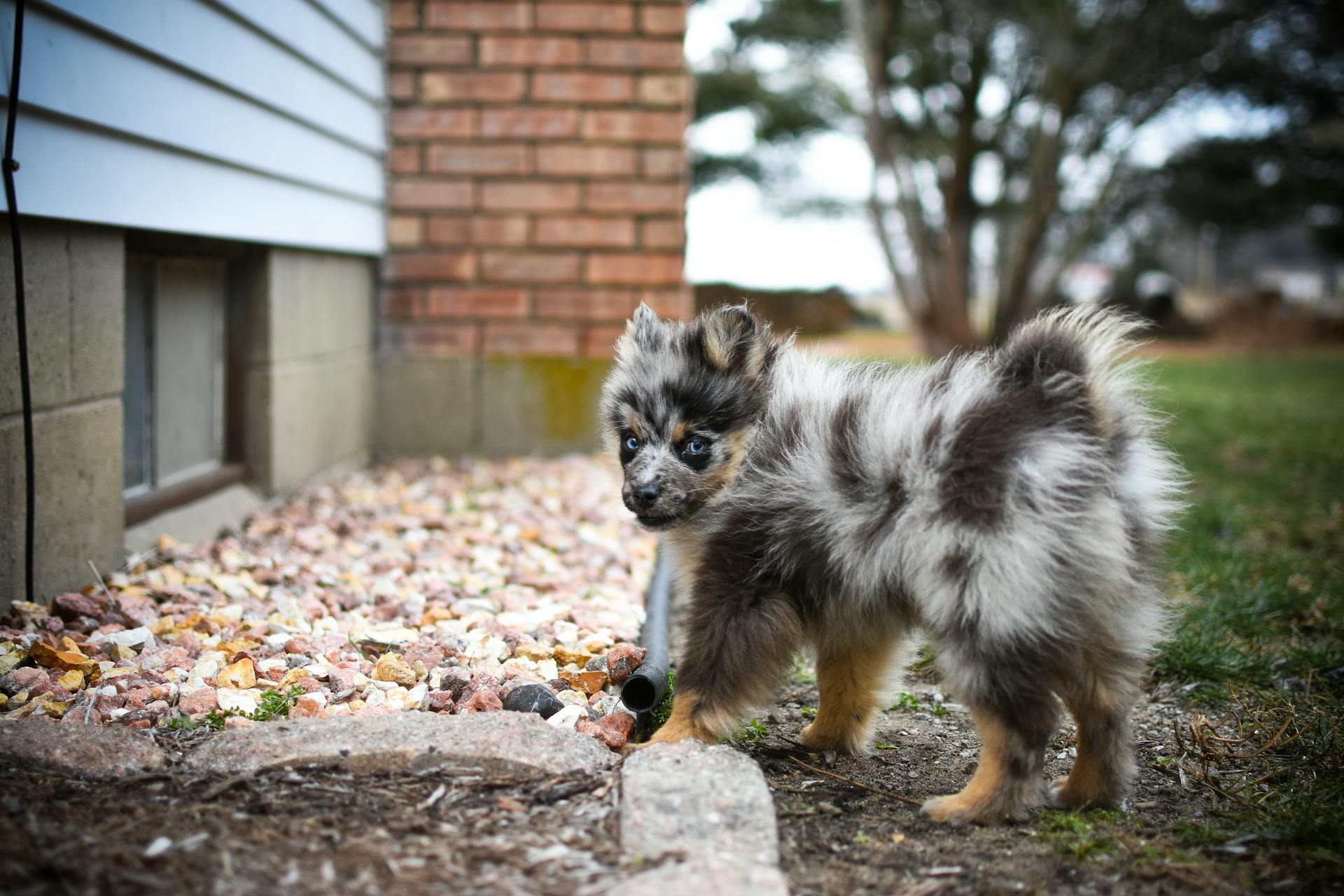
Here are some possible reasons for training regression:
- Waiting too long to take them out for potty breaks
- Not paying attention to the signs that they need to go
- Emotional problems, such as stress and anxiety from a change in their environment
- They may be sick to their stomach, have an infection, such as a urinary tract infection (UTI), or, if they are older, canine cognitive decline (doggie dementia)
If your vet says your puppy is okay, but they seem to have forgotten their house training, put them back on their regular schedule and supervise them while they're inside. Build your dog's confidence by playing with them and giving them a chance to work off stress and anxiety.
Don't Tell Him It's Time to Leave
Don't assume your dog will magically know it's time to leave the house, just like that. In fact, waiting for your young dog to tell you it's time to go is like asking a human baby to tell you to change his diaper.
Some dogs, especially toy breeds, never signal that they need to go potty. You need to be proactive and take them out on a regular schedule and routine.
Waiting for your dog to bark or whine won't work, as every dog has a different signal when they have to go potty.
Create a Schedule
Creating a schedule is crucial for housetraining your puppy. Puppies can hold their pee for the number of hours corresponding to their age in months up to about nine months to a year. This means a 6-month-old puppy can reasonably be expected to hold it for about 6 hours.
To set up a schedule, monitor daily events and your puppy's habits. With very young puppies, you should expect to take them out frequently, ideally every 2 hours or so during the day, and at least every 2.5 hours before bedtime.
Here are some specific times to take your puppy out:
- First thing in the morning and last thing at night
- After playing indoors
- After spending time in a crate or upon waking up from a nap
- After chewing a toy or bone, eating, or drinking
Remember, consistency is key, so try to stick to the same schedule every day, even on weekends or days off. If you work outside the house, make arrangements for your puppy to be taken out during the day, such as hiring a dog walker or asking a neighbor to help.
A unique perspective: My Dog Barks All Day While I Am at Work
Tips and Strategies
If you're new to housetraining, it's essential to manage your environment to ensure your dog's success. Confining your dog or keeping her in your sight at all times allows for immediate feedback and prevents mistakes.
Using a leash tethered to your waist, also known as an umbilical, can strengthen the bond between you and your dog and calm an excitable dog. This is especially helpful when you're not able to keep a close eye on your dog.
Baby gates can be a lifesaver in supervision, allowing you to keep an eye on your dog while still giving her some freedom. You can also use a "drag line" or a crate to limit your dog's freedom and prevent accidents.
A kitchen timer can be a great tool to remind you to take your dog out on a schedule. This will help you stay on top of housetraining and prevent mistakes.
Check this out: How to Entertain Dog While at Work
Understanding Housetraining
Housetraining is a process that requires patience, consistency, and understanding of your dog's individual needs. Dogs can hold their pee and poop for longer periods than puppies, making it easier to train older dogs. Housetraining is not just about eliminating accidents, but also about teaching your dog to go potty in a specific spot.
A dog's sense of smell plays a crucial role in housetraining, as they use their nose to identify where they've eliminated before. Consistency is key, so go out the same door each time for potty and to the same area. Think of it as area training, where you create a smelly area that screams "potty here!" by leaving your dog's scents in the designated area.
Here are some signs to watch for when observing your dog's potty habits:
- Whining and scratching: a signal that your dog needs to go
- Playing and excitement: some dogs may need to go out after playtime
- Stopping in the middle of a play session: some dogs may need to pee and then continue playing
Remember, every dog is different, and it's essential to understand their individual rhythms and signals. By watching your puppy carefully and supervising their potty habits, you can tailor your housetraining approach to their unique needs.
The Basics
Take your dog outdoors on a schedule, as she can hold it for a short period of time. Even young puppies can resist urination for at least an hour for each month of age.
You should take your dog to the same place to eliminate every time, as this helps create a visual association with that location and the reason why they're being taken there. Dogs generally like to eliminate where they've done so before.
Consider reading: Best Breed of Rabbit for First Time Owner
Assume that puppies may need to eliminate after eating, naps, strenuous play, or whenever there's a change of activity. This is especially important for young puppies, who can get overwhelmed easily.
Adult dogs should be given an opportunity to go out about every four hours when possible, but can reasonably be expected to hold their urine for 8 hours or longer. Some medical conditions can make it necessary for an adult dog to urinate more frequently.
Take your dog to the same exit door every time you take her out, as this helps her learn to signal her needs to you. However, not all dogs learn to signal automatically, so be patient and aware of their cues.
For another approach, see: How to Learn Dog Grooming
Crates as Potty Tools
Dogs are den animals and will seek out a little canine cave for security, making it relatively easy to train your dog to love their crate.
A crate should be the right size, just large enough for the dog to lie down, stand up, and turn around. If it's too large, the dog will feel that it's OK to use one corner for elimination and then happily settle down away from the mess.
Suggestion: Crate Training Is Cruel
Dogs are very clean creatures and don't like a urine-soaked rug in their living spaces any more than you do. If your dog is eliminating in the crate, even after short periods of time, this may be an indication of separation or confinement anxiety.
A crate can be a great tool for confining your dog at night, when you're gone for short periods, and when you're home and unable to supervise her. If you let your dog lose control in their crate, they'll get the idea that it's OK to mess up their living space.
Here's a general rule for crate size:
You can also use a crate to help with housetraining, but remember that a crate is not a substitute for regular potty breaks.
Observing and Supervising
Your dog's potty habits are highly idiosyncratic, meaning they can be unique to their individual needs and rhythms. Some puppies may be able to hold it longer than others, while some will have to go out every time they play or get excited.
To observe your dog's signs that they need to go outside, look for behaviors like barking, scratching at the door, squatting, restlessness or pacing, sniffing, and circling. These are all cues that your dog is ready to go potty.
You should take your dog out to their potty spot right away when you see any of these signs, and praise and reward them immediately after they use the correct spot. Consider bell training as a way for your pup to communicate their need to go out, and hang a bell on your door handle so they can ring it to let you know they need to go.
Here are some common signs that your puppy needs to go outside:
- Barking
- Scratching at the door
- Squatting
- Restlessness or pacing
- Sniffing
- Circling
By watching for these signs and taking your dog out to their potty spot right away, you can help them learn to communicate their needs and make the housetraining process easier for both of you.
Cats
Housebreaking a kitten is different from housebreaking a puppy. A kitten's toilet area would be a litter box inside the house, rather than a particular spot outside the house.
A kitten's instinct is to excrete within a substrate, and then to scratch and dig to hide the excretion. Litter boxes support this natural behavior.
Cats prefer a scent-free clumping clay substrate, according to most veterinarians. This type of substrate helps to reduce odors and makes cleaning easier.
The litter box should be in a quiet area so that the kitten would not feel agitated by the setting of its toilet area. A quiet location also helps to prevent accidents outside of the litter box.
To introduce the kitten to its toilet area and acquaint it with the substrate, it should be placed in the prepared litter box. The kitten should be placed in the litter box again after it has eaten, as that is when its urge to excrete is the strongest.
For more insights, see: Toilet Training Adult Dog
Most kittens take to litter boxes immediately if the substrate is to their liking. However, cats have different preferences, and some cats may prefer separate litter boxes for urine and feces.
You can consider the following factors when choosing a litter box for your kitten:
Remember, every cat is different, and what works for one kitten may not work for another. Be patient and observe your kitten's preferences to find the best solution for your household.
Toilet Training an Older Child
Toilet Training an Older Child can be a bit tricky, but it's definitely doable with patience and consistency. Older children, like older dogs, can hold their pee and poop for longer periods of time, making the process easier.
Establishing a regular schedule is key. Feed your child at regular times and pick up their plate 10-15 minutes after putting it down, even if there's still food left. This helps their digestive system get into a routine.
Taking your child to the bathroom at set times, like after meals and before bed, can help them learn when it's time to go. This is similar to how we take our dogs out at set times to do their business.
If your child has an accident, stay calm and don't scold them. Instead, calmly clean the area with an enzyme cleaner to remove any lingering odors that might attract them to the same spot again.
It's also a good idea to create a routine for your child to follow, like going to the bathroom right after waking up and before bedtime. This can help them develop good habits and make the process easier for both of you.
The Myths of
Dogs are smart and just trying to relieve themselves when they potty in the house, often choosing areas that aren't part of their "den" or home.
They tend to pick areas that the family doesn't spend a lot of time in and that are carpeted, if possible.
Think about it from your dog's perspective: if you had to potty on four feet, you'd choose an absorbent surface too.
Gate off these unused areas or spend extra time in them, introducing them slowly so your dog begins to understand they're also part of the home.
Dogs don't know or feel guilt when they potty in the house; they're just trying to calm you down with appeasement gestures.
They don't understand what they did wrong, they just know you're upset by your tone and body language.
Remember, dogs live in the moment and don't know past or present.
Correcting a dog after the fact can cause confusion and a fearful dog; it's essential to reward or correct within that 1.6-second window.
Troubleshooting Common Problems
If your puppy is having trouble with housetraining, don't worry, it's not uncommon. Sometimes, house soiling is a sign of a physical issue that needs to be addressed.
A good veterinary workup is essential before seeking out a trainer or behaviorist. Well before the several month mark, a dog who has seemed impossible to housetrain should have a good veterinary workup.
If your vet finds that your dog is healthy, it's time to find a professional who can help. A trainer or behaviorist with experience in this area can make all the difference.
Some common complaints that trainers encounter include house soiling.
Here's an interesting read: Indoor Dog House Training
Frequently Asked Questions
How do you stop a dog from peeing and pooping in the house?
To stop a dog from peeing and pooping in the house, immediately take them to their designated bathroom area and reward them for successful elimination. Clean up accidents thoroughly without punishing your dog, as punishment can create more problems.
What does it mean if a dog is house trained?
A dog that's house trained can stay indoors for several hours without having an accident, holding its bladder until it's taken outside to relieve itself. This means you can trust your dog to behave responsibly in the house.
What is housetraining a puppy?
Housetraining a puppy involves teaching them to eliminate in specific areas, such as outdoors or designated indoor spots, through a process called conditioning. By establishing good habits, you can help your puppy learn to toilet in the right places and avoid accidents.
Sources
- https://www.akc.org/expert-advice/training/how-to-potty-train-a-puppy/
- https://www.webmd.com/pets/dogs/house-training-your-puppy
- https://en.wikipedia.org/wiki/house-breaking
- https://indoorpet.osu.edu/dogs/puppy/housetraining-dogs
- https://carolscaninetraining.com/training/housetraining-and-the-adopted-dog/
Featured Images: pexels.com
